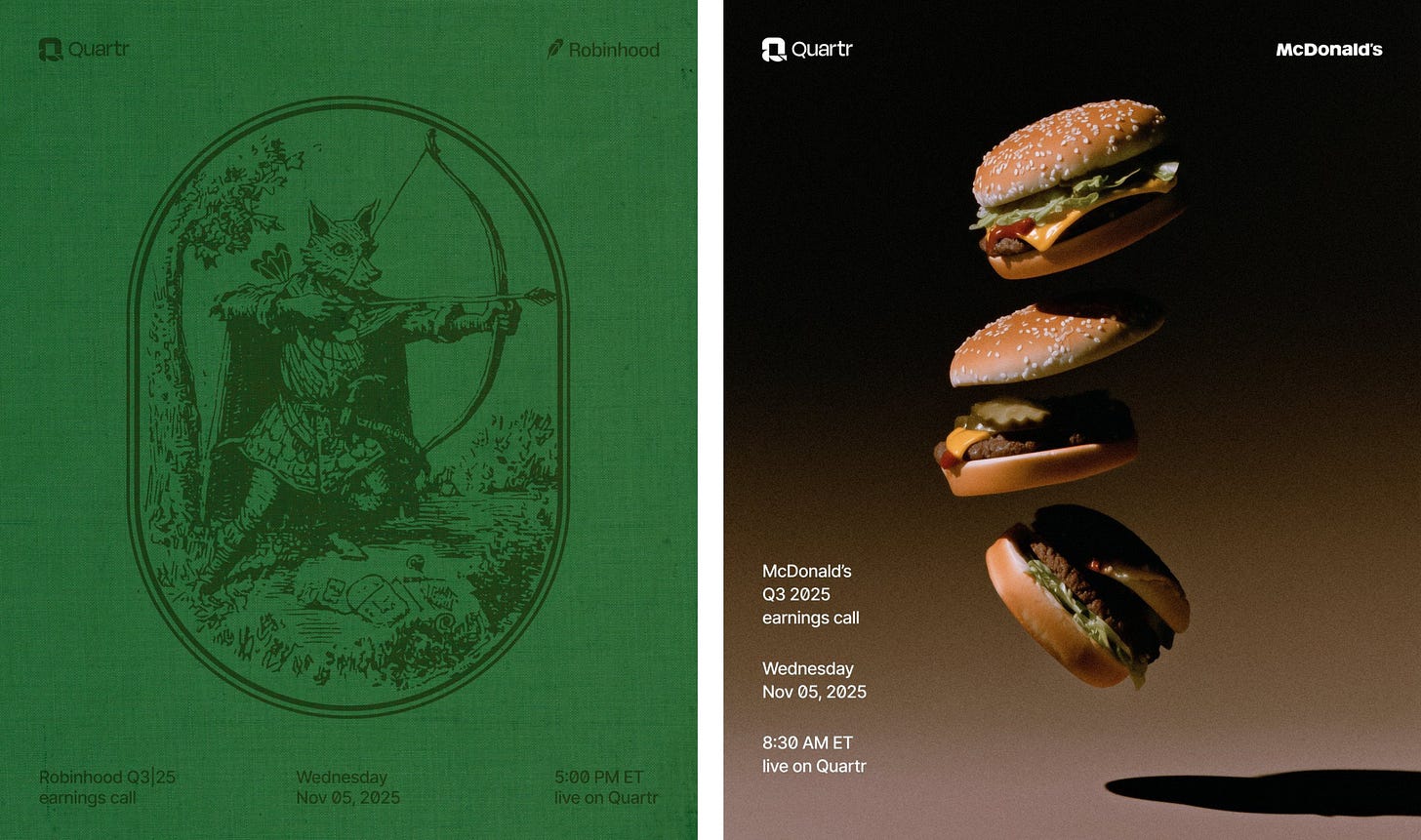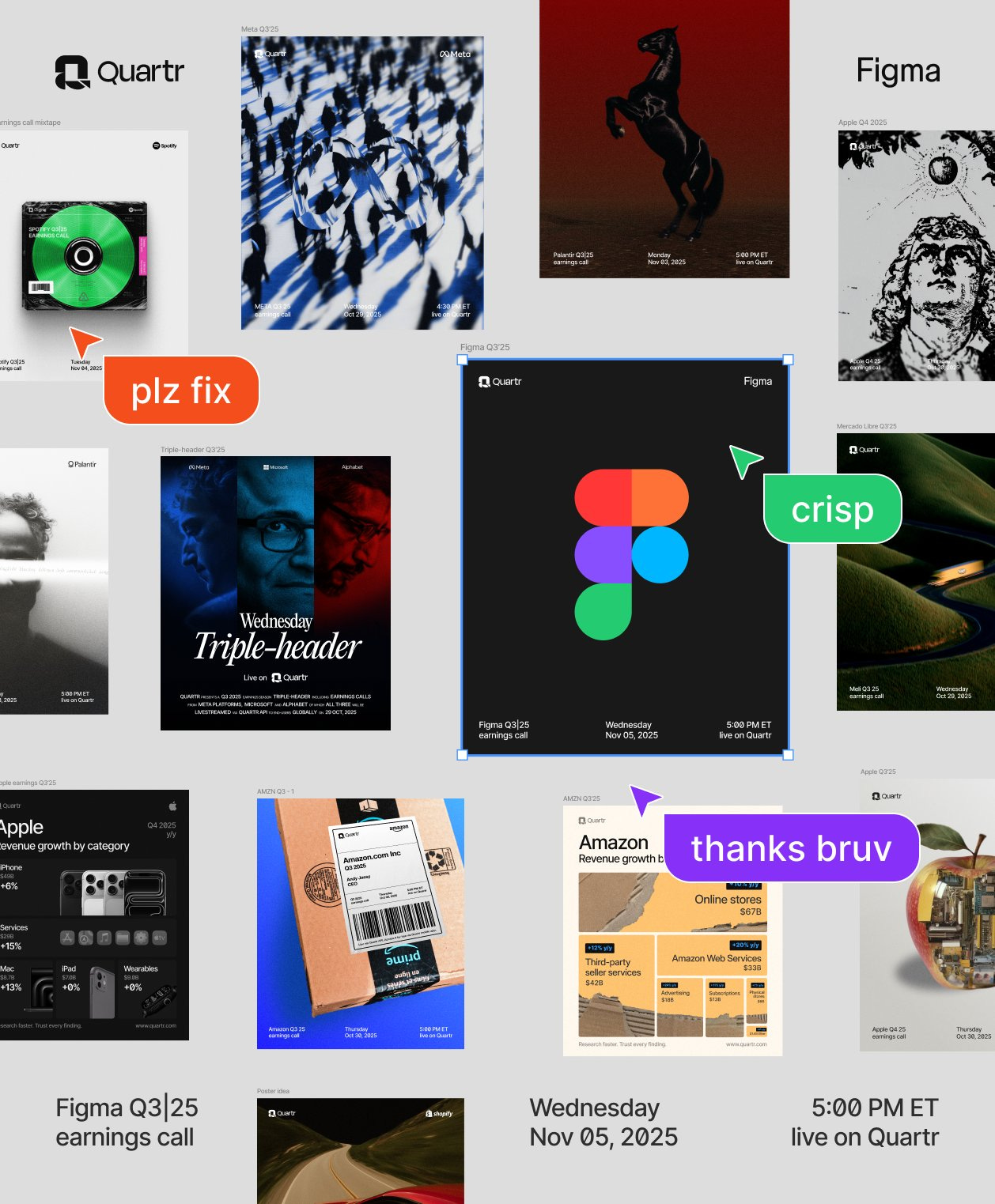How Quartr broke through on X
I talked to Oliver Hamrin, Co-Founder and Brand Strategist at the software company, about their viral earnings call posters.
Expectations play a big role in social media success. Does a brand meet audience expectations of how they should show up online? Or do they subvert and twist expectations? The good stuff usually happens in the latter.
Last week, a brand broke through by doing something unexpected on X. Software company Quartr gained traction with their simple earnings call posters. Every day there was a new image promoting an earnings call that you could listen in on via their app. The design style leaned more fashion than finance. Audiences expected stuffy, and they got slick.
I thought maybe it was just my oddly tech-focused X algorithm bubbling these posts up. But the like counts grew. They were shared in the Link in Bio Discord. One of my favorite follows Guillaume Huin, Marketing Director at McDonald’s, weighed in with, “Quartr creates earnings call announcement posts like high-end movie or museum posters. The ones for Tesla, Robinhood, Uber, Ferrari, and McDonald’s are literally frame-worthy. Letting the craft talk in places where it is the least expected is a cheat code to capture attention.”
For today’s newsletter, I talked to Oliver Hamrin, Co-Founder and Brand Strategist at Quartr. We cover the creative process for making the posters, how the virality has impacted their business, and why one of the biggest risks a brand can take is “being too creatively conservative.”
Rachel Karten: First, can you tell me a bit about Quartr and your role at the company?
Oliver Hamrin: Quartr is a software company founded in Stockholm in 2020. Through our products, we help leading companies and financial institutions research public companies faster and understand them deeper. Our customer base ranges from smaller asset managers and IR departments to some of the largest hedge funds and tech companies in the world.
I’m one of five co-founders and currently serve as our Brand Strategist, meaning I spend a lot of time with art direction, graphic design, messaging, and positioning. I’m one of three designers in the marketing team and produce a lot of what you’re seeing in for example social media, our newsletter Edge etc.
RK: I recently discovered your app on X. Your earnings call posters have gone a bit viral. I scrolled back on your account and you’ve actually been publishing these for quite awhile, so they aren’t necessarily new. Is it correct to say that your Palantir one is what really kicked off this online frenzy?
OH: I’m not sure what kicked it off, but it might have been that one. I think both the McDonald’s and the Ferrari poster caught fire early as well. And yes, we’ve been creating these and similar content for years. I think this was the first time we got more attention outside of our own industry.
RK: Can you give me a peek into the design process for the earnings call posters? What does that brainstorm and creative ideation look like?
OH: First of all, what we do isn’t technically complex or groundbreaking at all. We use the same tools as everyone else, mainly Figma and Midjourney, but I think our main advantage is a combination of taste and creativity, and the fact that we dare to leverage it in a conservative industry.
The ideation process isn’t complex either, we simply play around with visual concepts and try to challenge each other to reach the most beautiful or striking result. We’re not afraid of hurting feelings by criticizing each other in this process. That’s the only way to evolve. We’re self-taught and have been designing for just a few years, which might put us at a disadvantage in some regards, but on the other hand I have decided to remove as many creative limits as possible to help us think outside the box.
RK: Which one is your personal favorite? Why?
OH: That’s a hard question. I usually get tired of them quite quickly actually, instead focusing on how to make the next one even better. Concept-wise, I think the meta-style Figma poster we did was quite clever. I’m a sucker for nature photography too so I really like the Dole one as well. And it’s hard to not mention the Robinhood poster…
RK: What makes them stand out is that I think they feel visually unexpected for a tech company. Are there other industries you’re pulling inspiration from?
OH: I think it stands out simply because finance art direction/branding, especially on the B2B side where we operate, is usually dull and conservative. I think our inspiration comes from all over the place, including: music, nature, movies with striking cinematography, album and book covers, old adverts, fine art, and photography. I believe one of the biggest risks a brand can take is being too creatively conservative and looking too closely at its peers.
RK: What role is AI playing in the creation of these posters? I’ve noticed there are a lot of people debating how you’re making them.
OH: It’s usually a mix of photos, vector, overlays, and AI-generated imagery, while some are just one of the above.
RK: Are you able to share the impact the recent virality has had on your business? Have you seen an increase in app downloads?
OH: We’re seeing clear spikes across mobile app downloads, inbound leads for Quartr Pro and Quartr API, website traffic, Edge newsletter subscribers etc, but perhaps most importantly we’ve attracted hundreds of ambitious people who want to join our team. I think our quality obsession and creative thinking is rare in tech and finance, and that attracts people.
RK: Besides X, are there any other social media platforms that you’d consider a priority for Quartr?
OH: We’re only focusing on X and LinkedIn at the moment. It’s where we most easily can reach our core target groups. We’d rather leverage a few channels really well than spread ourselves too thin.
RK: I’m not sure if it’s just my X algorithm, but I’ve noticed a real focus from tech companies on marketing right now. Hiring storytellers, creating cinematic launch videos, honing design styles. Why do you suspect this is happening at this moment?
OH: I think people are suddenly realizing that as tools are quickly getting better, cheaper, and easier to use, the technical playing field will level – across everything, from productivity, to coding, to design. We’re in a situation where the rising tide is lifting all boats, and sort of disrupting the middle layer in many markets by helping, for example, lower-tier creatives reach mid-level quality while the top-tier creatives are given even more power. I’m convinced that innate human elements like creativity, taste, and intuition will become even more important for companies to stay competitive going forward.
RK: Finally, I’ve already noticed people copying your design style. How do you continue to stand out?
OH: Good question. I hope our creative restlessness, continued pursuit of new ideas, and few limitations will help us stay relevant and set new trends. It’s what we’ve been doing since day one, so I’m not that worried. We’ve been copied multiple times before.
If you enjoy free interviews like this one, you can upgrade to a paid Link in Bio subscription. You’ll get weekly strategy newsletters and quarterly trend reports, along with access to the very active Discord community.
One member shared, “The Link in Bio Discord has been an absolutely invaluable part of my growth as a social media professional. It’s allowed me to meet so many fascinating and talented folks in an industry that can often feel like living on an island, and helped me contextualize a lot of the mysteries of social.”
It might even be an educational expense at your company! Here’s a template for you to use when asking.
Finally, since today was an interview, you can expect the strategy newsletter for paid subscribers on Thursday! See you then.







Turning the mundane into the memorable. Mouton Rothschild (a ridiculously expensive wine 🍷) has been partnering with artists since 1924. The likes of Picasso, Dali and more recently Olafur Eliasson have had their artwork feature on the wine's label. Up until natural wine became a thing wine labels seemed to stick in an old world lane of design. Rothschild understood the power of design and good influencer strategy in 1924.
Perfect example of how taste beats budget. When everyone’s using the same AI tools, the real edge goes to the ones who know what to skip and aren’t afraid to ignore what everyone else in their industry is doing.